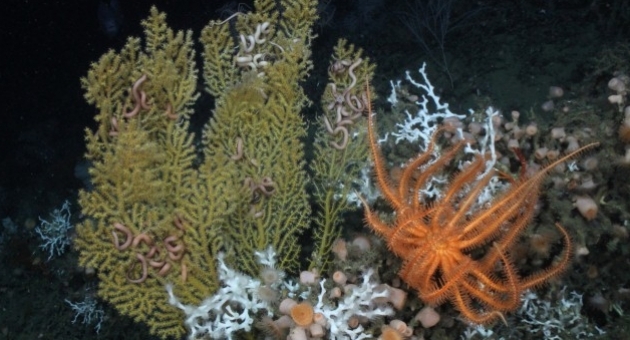Biology faculty and students explore deep-sea coral in the Gulf

Imagine spending eight hours in a space that is six feet in diameter—with two other people. Oh, and you are about one mile beneath the surface of the Gulf of Mexico.
That scenario describes where Assistant Professor of Biology Erik Cordes is right now: on a scientific voyage to study how ocean acidification and climate change are affecting deep-sea coral. The tight quarters belong to Alvin, a U.S. Navy-owned submersible that has helped spur many insights into deep-sea geology, chemistry and biology.
“We’ll be looking for corals that show an ability to grow under very harsh conditions,” said Cordes before the trip. “These coral reefs are already more acidic—due to their depth and rise in atmospheric carbon-dioxide levels—than any other on earth, yet they survive.”
Cordes, whose research is funded by the National Science Foundation (NSF), and his team recently boarded the research ship Atlantis for a voyage across the Gulf from April 27 to May 16. The team includes Assistant Professor of Biology Rob Kulathinal, co-principal investigator on the NSF grant, and Professor of Biology Robert Sanders.
“I’m a lab-reared genomicist, so these opportunities typically do not present themselves,” said Kulathinal, who is examining gene expression changes of Lophelia pertusa coral at different levels of acidity. “We will also map the distribution of genetic variation found in other deep-sea corals.”
Sanders—whose research focuses on the microbial food web in oceans and lakes—is gathering data on organisms that feed on bacteria in surface waters and in the deep chlorophyll maximum, a depth stratum rich in phytoplankton and other microbes, and near oil seeps on the ocean floor.
Cordes and his team will complete up to 18 dives, gathering coral specimens to conduct experiments at sea and perform genomic analysis back at Temple University. Each dive starts at 6:00 a.m. with a full safety check. At night, the team uses Sentry—an autonomous vehicle—to map and photograph the ocean floor. A small film crew is accompanying the team to chronicle Cordes’ work for Acid Horizon, a documentary about his research.
Among the researchers are four graduate students from the Cordes lab: Alanna Durkin, Carlos Gomez, Sam Georgian and Danielle Young.
“For most people in our field, getting an Alvin dive is the pinnacle of their careers,” Georgian said. “For graduate students, it’s a rare experience.”
Georgian is examining the coral’s respiration and feeding rates, manipulating carbon-dioxide levels to gauge their impact and looking at natural variations of specimens found at different sites. Young is on her third research voyage, but it is her first trip in Alvin. She is studying the effects of the 2010 Deepwater Horizon oil spill on two species of soft corals.
Of the team of 18 researchers, all but two have never been on board Alvin before. Cordes’ advice for first-timers is: “You will be incredibly busy, but make sure you take a moment to enjoy the feeling of being on the bottom of the ocean.”
-- Greg Fornia